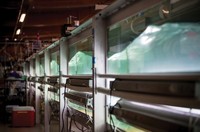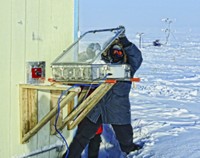Advertisement
Grab your lab coat. Let's get started
Welcome!
Welcome!
Create an account below to get 6 C&EN articles per month, receive newsletters and more - all free.
It seems this is your first time logging in online. Please enter the following information to continue.
As an ACS member you automatically get access to this site. All we need is few more details to create your reading experience.
Not you? Sign in with a different account.
Not you? Sign in with a different account.
ERROR 1
ERROR 1
ERROR 2
ERROR 2
ERROR 2
ERROR 2
ERROR 2
Password and Confirm password must match.
If you have an ACS member number, please enter it here so we can link this account to your membership. (optional)
ERROR 2
ACS values your privacy. By submitting your information, you are gaining access to C&EN and subscribing to our weekly newsletter. We use the information you provide to make your reading experience better, and we will never sell your data to third party members.
People
ACS Award For Creative Advances In Environmental Sciences & Technology
Recipients are honored for contributions of major significance to chemistry
by Cheryl Hogue
February 2, 2009
| A version of this story appeared in
Volume 87, Issue 5
Sponsored by Air Products & Chemicals Inc., in memory of Joseph J. Breen
By Margaret A. Tolbert's reckoning, her award-studded career in atmospheric chemistry started because she was in the right place at the right time.
The right time was the mid-1980s, when massive and unexplained stratospheric ozone depletion was discovered over Antarctica. Researchers with the National Oceanic & Atmospheric Administration (NOAA) suggested a key step in this ozone depletion might be heterogeneous reactions involving gases interacting with or on particles.
Tolbert was then a postdoctoral researcher at SRI International, a nonprofit scientific research institute in Menlo Park, Calif. That was the right place to be, she says, because "we had the right equipment" to test NOAA's hypothesis in the laboratory.
"We found that, indeed, heterogeneous reactions on ice did convert inert chlorine into more active forms," Tolbert says. Most of the anthropogenic chlorine in the stratosphere comes from chlorofluorocarbons. When CFCs break down, they are converted into species such as hydrogen chloride and chlorine nitrate. These species react on polar stratospheric clouds, releasing active chlorine that goes on to destroy ozone.
Results of the experiments identifying the heterogeneous reactions in stratospheric ozone depletion were published in a landmark paper (Science 1987, 238, 1258). For it, Tolbert was a corecipient of the American Association for the Advancement of Science's Newcomb Cleveland Prize for authorship of the best paper of 1987 in the journal Science.
That publication was one of a series of articles that have had major influence on the field of atmospheric chemistry, says Barbara J. Finlayson-Pitts, a chemistry professor at the University of California, Irvine. "Tolbert established that a number of reactions that are slow in the gas phase become quite rapid when one of the gases, such as hydrogen chloride, is adsorbed on an ice surface, due primarily to the ionic nature of acids in or on ice," she says.
Tolbert, 51, is now a professor of chemistry at the University of Colorado, Boulder. She earned an undergraduate degree at Grinnell College, in Iowa; received a master's degree from the University of California, Berkeley; and got a doctorate at California Institute of Technology. She was elected to the National Academy of Sciences in 2004 and won a Guggenheim Fellowship in 2005.
More than two decades after publication of Tolbert's Science paper, the chemistry of polar stratospheric clouds remains on the agenda in her laboratory at the Cooperative Institute for Research in Environmental Sciences. The institute is a joint research venture between the University of Colorado, Boulder, and NOAA.
Tolbert's current work on polar stratospheric clouds relates to predictions of ozone loss as global warming intensifies and as releases of chemicals linked to ozone depletion decrease. Her laboratory is probing the chemical composition of clouds in the polar winter stratosphere, more of which are expected to form in the future as a result of climate change.
Her research now stretches beyond stratospheric ozone depletion. Today, most of Tolbert's investigations are focused on clouds and aerosols in the troposphere that can reflect and absorb the sun's light. Clouds and particulates typically exert an overall cooling effect on the planet, although some clouds lead to warming. Tolbert hopes her group's work will help reduce uncertainty in projections of future climate change.
In her newest project, Tolbert is reaching back in time and out into space. Her team is investigating aerosols and clouds as they may have existed on Earth about 3.5 billion years ago in an atmosphere composed mainly of nitrogen with smaller amounts of water vapor, carbon dioxide, and possibly methane. To do this, her group is studying aerosols in the analogous methane- and nitrogen-rich atmosphere of Saturn's largest moon, Titan.
Clearly, just what constitutes the "right place and right time" has expanded during Tolbert's career. Today, it is anywhere—even elsewhere in the solar system—and anytime—past, present, or future—that she can explore unanswered questions about atmospheric chemistry.
Tolbert will present the award address before the Division of Physical Chemistry.






Join the conversation
Contact the reporter
Submit a Letter to the Editor for publication
Engage with us on Twitter